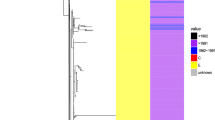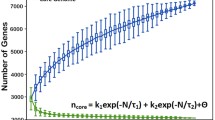Abstract
Identification of potential drug targets is the first step in the process of modern drug discovery, subjected to their validation and drug development. Whole genome sequences of a number of organisms allow prediction of potential drug targets using sequence comparison approaches. Here, we present a subtractive approach exploiting the knowledge of global gene expression along with sequence comparisons to predict the potential drug targets more efficiently. Based on the knowledge of 155 known virulence and their coexpressed genes mined from microarray database in the public domain, 357 coexpressed probable virulence genes for Vibrio cholerae were predicted. Based on screening of Database of Essential Genes using blastn, a total of 102 genes out of these 357 were enlisted as vitally essential genes, and hence good putative drug targets. As the effective drug target is a protein which is only present in the pathogen, similarity search of these 102 essential genes against human genome sequence led to subtraction of 66 genes, thus leaving behind a subset of 36 genes whose products have been called as potential drug targets. The gene ontology analysis using Blast2GO of these 36 genes revealed their roles in important metabolic pathways of V. cholerae or on the surface of the pathogen. Thus, we propose that the products of these genes be evaluated as target sites of drugs against V. cholerae in future investigations.



Similar content being viewed by others
References
Altschul SF, Madden TL, Schäffer AA, Zhang J, Miller W, Lipman DJ (1997) Gapped BLAST and PSI-BLAST: a new generation of protein database search programs. Nucleic Acids Res 25:3389–3402
Bergmann S, Ihmels J, Barkai N (2004) Similarities and differences in genome-wide expression data of six organisms. PLoS Biol 2:e9
Camara M, Hardman A, Williams P, Milton D (2002) Quorum sensing in Vibrio cholerae. Nat Genet 32:217–218
Conesa A, Gotz S, Garcia-Gomez JM, Terol J, Talon M, Robles M (2005) Blast2GO: a universal tool for annotation, visualization and analysis in functional genomics research. Bioinformatics 21:3674–3676
Eisen MB, Spellman PT, Brown PO, Botstein D (1998) Cluster analysis and display of genome-wide expression patterns. Proc Natl Acad Sci USA 95:14863–14868
Galperin MY, Koonin EV (1999) Searching for drug targets in microbial genomes. Curr Opin Biotechnol 10:571–578
Garg A, Gupta D (2008) VirulentPred: a SVM based prediction method for virulent proteins in bacterial pathogens. BMC Bioinform 9:62
Groth P, Weiss B, Pohlenz HD, Leser U (2008) Mining phenotypes for gene function prediction. BMC Bioinform 9:136
Gray CP, Keck W (1999) Bacterial targets and antibiotics: genome-based drug discovery. Cell Mol Life Sci 56:779–787
Hasan S, Daugelat S, Rao PS, Schreiber M (2006) Prioritizing genomic drug targets in pathogens: application to Mycobacterium tuberculosis. PLoS Comput Biol 2:e61
Hefti FF (2008) Requirements for a lead compound to become a clinical candidate. BMC Neurosci 9:S7
Higgins DE, Nazareno E, DiRita VJ (1992) The virulence gene activator ToxT from Vibrio cholerae is a member of the AraC family of transcriptional activators. J Bacteriol 174:6974–6980
Hubble J, Demeter J, Jin H, Mao M, Nitzberg M, Reddy TB, Wymore F, Zachariah ZK, Sherlock G, Ball CA (2009) Implementation of GenePattern within the Stanford Microarray Database. Nucleic Acids Res 37:D898–D901
Judson N, Mekalanos JJ (2000) TnAraOut, a transposon-based approach to identify and characterize essential bacterial genes. Nat Biotechnol 18:740–745
Knell RJ (2006) New gene, new disease. Heredity 97:315
Kuruvilla FG, Shamji AF, Sternson SM, Hergenrother PJ, Schreiber SL (2002) Dissecting glucose signaling with diversity-oriented synthesis and small-molecule microarrays. Nature 416:653–657
Lee SH, Hava DL, Waldor MK, Camilli A (1999) Regulation and temporal expression patterns of Vibrio cholerae virulence genes during infection. Cell 99:625–634
Li Q, Lai L (2007) Prediction of potential drug targets based on simple sequence properties. BMC Bioinform 8:353
Lipinski CA, Lombardo F, Dominy BW, Feeney PJ (2001) Experimental and computational approaches to estimate solubility and permeability in drug discovery and development settings. Adv Drug Deliv Rev 46:3–26
Overington JP, Al-Lazikani B, Hopkins A (2006) How many drug targets are there? Nat Rev 5:993–996
Perumal D, Lim CS, Sakharkar KR, Sakharkar MK (2007) Differential genome analyses of metabolic enzymes in Pseudomonas aeruginosa for drug target identification. In Silico Biol 7:0032
Roemer T, Jiang B, Davison J, Ketela T, Veillette K, Breton A, Tandia F, Linteau A, Sillaots S, Marta C, Martel N, Veronneau S, Lemieux S, Kauffman S, Becker J, Srorms R, Boone C, Bussey H (2003) Large-scale essential gene identification in Candida albicans and applications to antifungal drug discovery. Mol Microbiol 50:167–181
Sakharkar KR, Sakharkar MK, Chow VTK (2004) A novel genomics approach for the identification of drug targets in pathogens, with special reference to Pseudomonas aeruginosa. In Silico Biol 4:0028
Sakharkar KR, Sakharkar MK, Chow VT (2008) Biocomputational strategies for microbial drug target identification. Meth Mol Med 142:1–9
Sharma V, Gupta P, Dixit A (2008) In silico identification of putative drug targets from different metabolic pathways of Aeromonas hydrophila. In Silico Biol 8:0026
Sridhar P, Song B, Kahveci T, Ranka S (2007) Mining metabolic networks for optimal drug targets. Pac Symp Biocomput 13:291–302
Sur D, Sarkar BL, Manna B, Deen J, Datta S, Nivoqi SK, Gosh AN, Deb A, Kanunqo S, Palit A, Bhattacharya SK (2006) Epidemiological, microbiological & electron microscopic study of a cholera outbreak in a Kolkata slum community. Indian J Med Res 123:31–36
Tamayo P, Slonim D, Mesirov J, Zhu Q, Kitareewan S, Dmitrovsky E, Lander ES, Golub TR (1999) Interpreting patterns of gene expression with self-organizing maps: methods and application to hematopoietic differentiation. Proc Natl Acad Sci USA 96:2907–2912
Ulm R, Baumann A, Oravecz A, Mate Z, Adam E, Oakeley EJ, Schafer E, Naqv F (2004) Genome-wide analysis of gene expression reveals function of the bZIP transcription factor HY5 in the UV-B response of Arabidopsis. Proc Natl Acad Sci USA 101:1397–1402
Van-Noort V, Snel B, Huynen MA (2003) Predicting gene function by conserved co-expression. Trends Genet 19:238–242
Yang J, Chen LH, Sun L, Yu J, Jin Q (2008) VFDB 2008 release: an enhanced web-based resource for comparative pathogenomics. Nucleic Acids Res 36:D539–D542
Zhang R, Lin Y (2009) DEG 50, a database of essential genes in both prokaryotes and eukaryotes. Nucleic Acids Res 37:D455–D458
Zhu J, Miller MB, Vance RE, Dziejman M, Bassler BL, Mekalanos JJ (2002) Quorum-sensing regulators control virulence gene expression in Vibrio cholerae. Proc Natl Acad Sci USA 99:3129–3134
Acknowledgments
The authors acknowledge the DBT center for bioinformatics facility at Department of Bioscience and Biotechnology, Banasthali University, Banasthali, India for providing essential facilities for completion of this research work. The authors also wish to thank Mr. Manish Roorkiwal, Guru Gobind Singh Indraprastha University, Delhi for critically reviewing the manuscript.
Disclosure statement
No competing financial interests exist.
Author information
Authors and Affiliations
Corresponding author
Additional information
Handling Editor: Reimer Stick
Pramod Katara and Atul Grover contributed equally to the manuscript.
Rights and permissions
About this article
Cite this article
Katara, P., Grover, A., Kuntal, H. et al. In silico prediction of drug targets in Vibrio cholerae . Protoplasma 248, 799–804 (2011). https://doi.org/10.1007/s00709-010-0255-0
Received:
Accepted:
Published:
Issue Date:
DOI: https://doi.org/10.1007/s00709-010-0255-0




